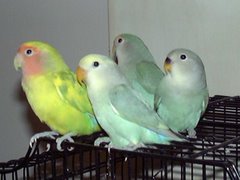Baby Lovebirds Caring Tips
Congratulations!!! So your lovebird is nesting now. Then,
this is high time to get to know about baby lovebirds caring tips. If you
haven’t cared your baby lovebirds well, you’ll lose them that could be a
discouraging experience.
Once you notice the baby lovebirds coming out of the nest,
this is the time you should intervene. If you allow the baby birds along with
the parents more than couple of weeks, the male bird will try to peck these
little birds. Remove them and rear the young ones in a sizable plastic-type
reptile container for first few weeks.
You should pull out the entire clutch at 10 days old; if you
want them to hand rear. Feed the infant birds with syringes along with
provision of adult food such as millets and greens. Fill the syringes half way
with baby lovebird liquid feed. You should pull the syringe out about 3-5
seconds of feeding. Wipe the beak with a tissue paper or soft cloth, then again
start feeding. Stop feeding once you feel that the crop is full. You should
place the hand-held syringe on the RIGHT side of the beak to push the feed on
left side, otherwise the bird will get choke.
Initially hand feed your bird with guidance from an
experienced trainer. You can buy baby bird formula available commercially.
As we know very well that the baby birds are fed with
regurgitated food by its mother in nature, you should provide them with warm
food (103 F). Check the food thoroughly after warm up in order to avoid hot
spots and stuff like that. If the food is too warm and fed the baby lovebirds
unnoticed, then there is possibility of CROP BURN.
If the baby birds stop wanting the syringes, this clearly
shows that they are completely independent. Now you can sell them to any other
owner after completely examining that there are no health issues.









 Free Ads For Bloggers
Free Ads For Bloggers

